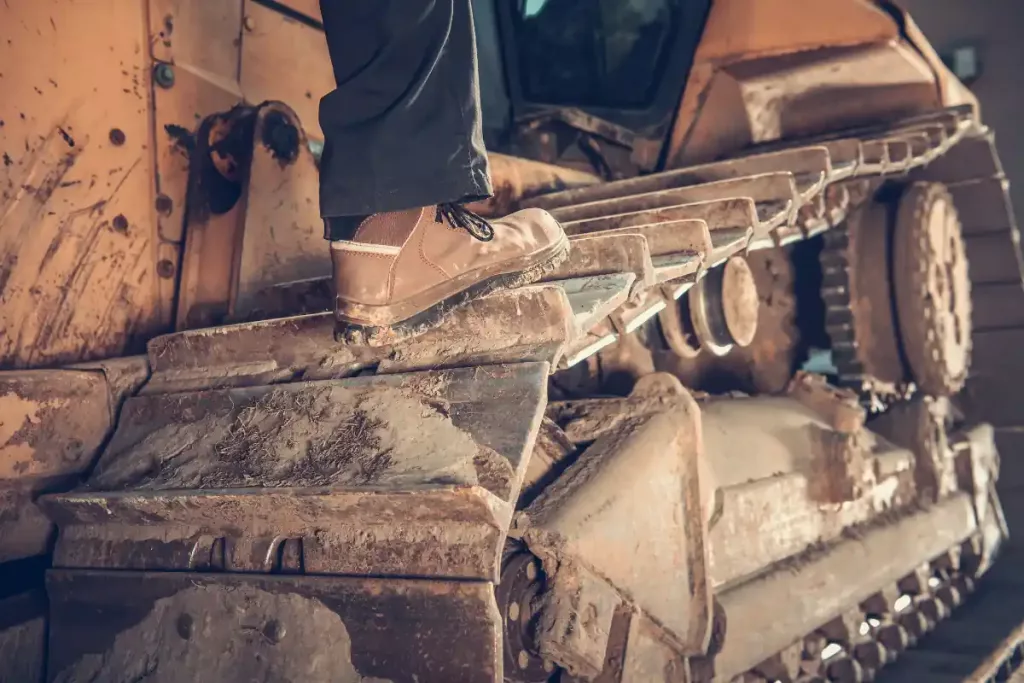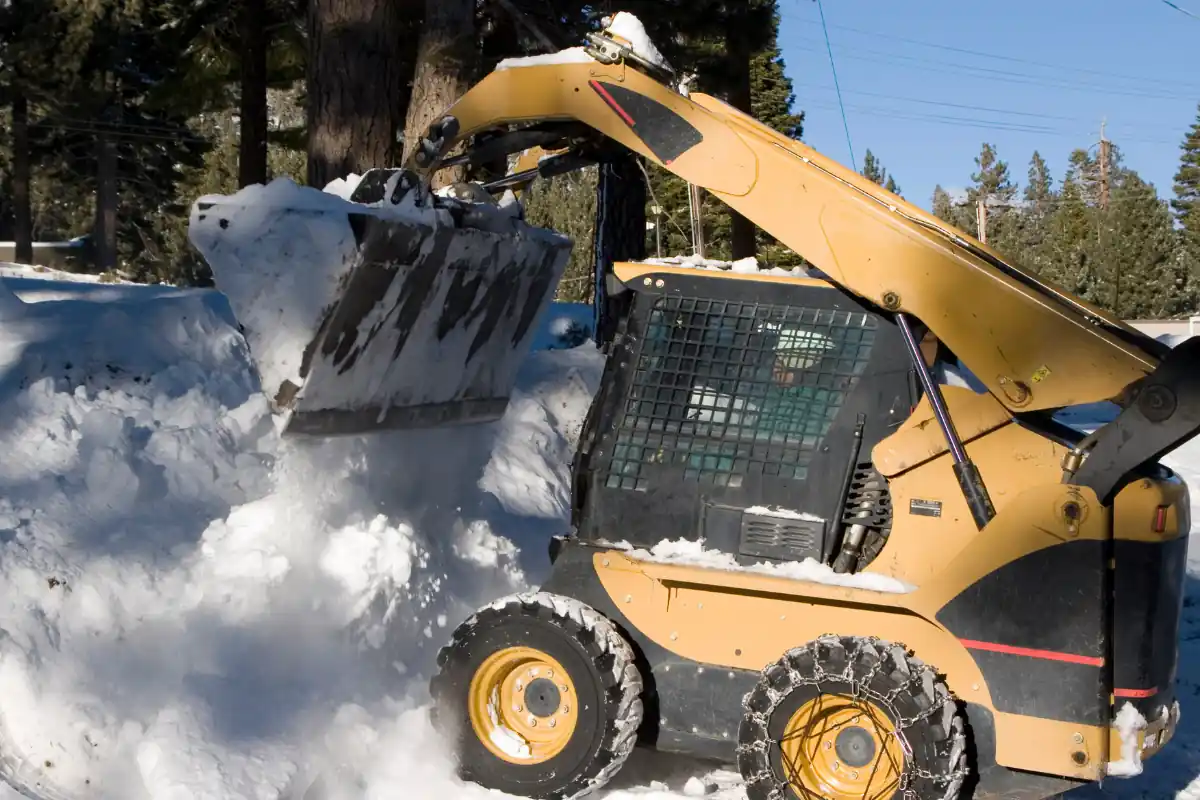When why do some bulldozers have high tracks is a question you’re asking, the answer might be as simple as “because they can.” It’s true that many of these heavy-duty vehicles are designed to be used on uneven terrain and in locations where steep grades or deep snow are common.
And when it comes down to it, if a vehicle was meant for use in rough conditions, then why wouldn’t you want to have a high track to give you a better ride and provide you, the operator, far more comfortable for your shift?

High Track Dozers vs Low Track
A bulldozer’s tracks are quite important because they help to balance the machine. It is important to consider the type of work that the bulldozer will be doing when choosing what kind of tracks you want for it.
Some bulldozers have high tracks because it allows them to be able to anchor themselves in tougher terrain and not tip over.
Other bulldozers have low tracks so that when they’re on flat terrain, their clearance from other parts on the machine is increased; this allows them to get closer to objects before scraping against them and causing damage.
Dozer tracks are the bottom part of the bulldozer, and there are several different kinds. There is a high track dozer which has its tracks raised so that it won’t tip over when working on hillsides or in thick forests.
The other type of dozer track is a low track one. This kind of dozer cannot work in tough terrain because if it had to raise its tracks, it would not have enough clearance from other parts on the machine resulting in damage being done to them as well.
A good example would be where the treads went over something like another rocker arm or backhoe bucket; this could cause damage to those components while trying to move forward in hillsides or forests.
To lessen damages caused by working in tough terrain, high track bulldozers are used.
Bulldozer Track Types & Their Uses
In general terms, there are two types of dozer track; they are the high-tread and low-tread. The only real difference between the two is that a low-tread has its treads at just about ground level, whereas high-tread have their treads elevated above the ground.
One reason why some dozer tracks are higher than others is because it allows the machine to work in different terrains without being damaged.
When operating in tough terrain such as a forest or hillsides, if a low tread was used this would mean that it wouldn’t be able to clear taller objects such as tree stumps or rocks and would hit them as it was operating.
This could result in damage to the machine and a loss of productivity.
This is why high-tread dozer tracks are used in these kinds of tough terrains. When work is being done on slopes or in the woods, the track can be elevated so that it doesn’t run into any obstacles while going up hillsides or across the ground.
This also allows for more traction to be used when trying to move large logs and other heavier objects that may have been picked up by the dozer blade
High – Tread Bulldozer
Some bulldozers are equipped with high-tread because they’re built mainly for rough terrain use, like mines, forests, quarries etc.
As the name implies, high-tread dozer tracks are higher than standard ones. What makes them different from originals is that their rubber pads and metal rims (which normally have ground clearance) are elevated a little higher than low tread types.
They also have more aggressive ‘lugs’ on their edges for more digging power in difficult conditions.
Low – Tread Bulldozer
The other type of dozer track is called the low-tread one. This kind has its treads at just about ground level, so it can get closer to objects before scraping against them and causing damage.
The original wheel’s raised surface stops after two or three inches and then the lower part moves forward in order to provide that same amount of clearance.
It’s because of this why you’ll rarely see a bulldozer with low-tread operating on rough terrain assignments, as they have much less traction and would strain heavily to churn through the ground.
These types are generally used for operations like grading or asphalt paving where there is little chance of running into rocks, stumps etc., that could cause damage.
If you want your dozer blade to pull off jobs in tough conditions, it should be equipped with high-tread tracks. By doing so you’ll get higher productivity compared to working in soft ones on flat surfaces.
However, if you just need them for regular landscaping work then standard treads are fine as they have at least 29″ of clearance (measured from the edge of the tread to the center of its bore) for easy operation.
What is the advantage of a high track bulldozer?
Bulldozers with high tracks are typically designed to work in tough terrain, such as forests or steep hillsides.
The advantage of a high track bulldozer is that when it encounters these sites, the bulldozer can raise its tracks so that it doesn’t tip over and dig into the earth’s surface.
For example, consider a forest where there is an overgrowth of trees and bushes. A bulldozer with low tracks might be able to get in there and clear the area, but it has just as high a chance of getting stuck or falling over as any other type of bulldozer.
In fact, some areas with tough terrain may even require an unusually shaped blade on the front of the machine for better maneuverability – one that looks something like a shark’s fin!
But why not make all bulldozers have high tracks?
Although higher tracks can provide more stability when working around thick brush or forests, they are often not necessary for most building projects. Most building sites aren’t located near dense greenery, so why build these bulldozers with high tracks?
Also, keep in mind that making a bulldozer higher increases its weight dramatically. This makes the machine harder to operate and generally more expensive than lower-track models. So why pay extra money for something you won’t need?
Bulldozers are typically made with either low or medium tracks instead, which provides just enough stability when working on building sites without adding too much weight to tire the operator out. The result is a sturdy construction tool that can be used all day long!
Pros and Cons of High Track Dozer
There are many reasons why you may want to buy a high track dozer. Many people are saying that the tracks on this type of machine are prone to breaking. The fact is, if you take care of it and prevent it from going over any hard objects, then it will serve you for many years to come.
Benefits to a High Track Dozer
– Versatility – high-track bulldozers are built to work in tough terrain like forests and steep hillsides
– Reliability – when these sites are encountered, the dozer can raise its tracks so that it doesn’t tip over and dig into the earth’s surface
– Safety – being on a slope or hillside is no problem; raising the track provides stability
Drawbacks to a High Track Dozer
– High Track Dozer does not offer as much visibility for the operator at the side of the machine
– High Tracking bulldozers have a higher center of gravity which can make them more unstable on rugged terrain
– The reduced length of treads on a high tracker leads to poorer clearance, traction and stability in off camber situations
Is a high track dozer better?
A high track dozer is better than a low-track dozer in certain aspects. They are able to move around more readily.
One of the problems with low-track bulldozers is that they can become less effective when they come across tough terrain or hill tops.
It can also be easier to tip over with a lower-track bulldozer, especially when working on hillsides or steep slopes.
A high-track dozer can better handle tough terrain. They have the ability to maneuver more easily on different kinds of terrains and work effectively even in rocky or uneven landscapes.
High-track bulldozers also make it easier for you to clear away tall vegetation as opposed to low-track bulldozers which are better suited for clearing shorter brush and bushes.
The biggest problem with a high-track dozer is that they’re much harder to keep under control while traveling through rough terrain, especially when on a steep hillside.
It’s easy to flip over if not careful enough because of how far off the ground the tracks are on a high-track dozer.
There really is no need why these types of bulldozers are built with higher tracks because they are not capable of clearing trees that are as tall as a normal low-track dozer.
The only scenario why it makes sense to use high-track bulldozers instead of low-track bulldozers is when you need to transport them over tough terrain, such as rocky or rough ground where the tracks can make contact with the surface and act like wheels.
It’s also easier for you to maintain control on a hillside with higher-track bulldozers than on lower ones.
The reason why high-track dozers can’t clear taller trees is because of how much heavier the machine becomes due to the machinery above the tracks.
The weight shifts so far forward in these types of machines that it becomes harder and more difficult for
In Summary
The answer is pretty simple: because they’re built to work in tough terrain, like forests or steep hillsides.
When these sites are encountered, the bulldozer can raise its tracks so that it doesn’t tip over and dig into the earth’s surface.”


![Find Job Opportunities [ Becoming a Dozer Driver ]](https://heavymachineryworld.com/wp-content/uploads/2021/06/how-much-do-bulldozer-drivers-make.jpg)

![Titles on Heavy Equipment [ Dealing with Theft or Sale ]](https://heavymachineryworld.com/wp-content/uploads/2021/06/do-heavy-equipment-have-titles.jpg)
